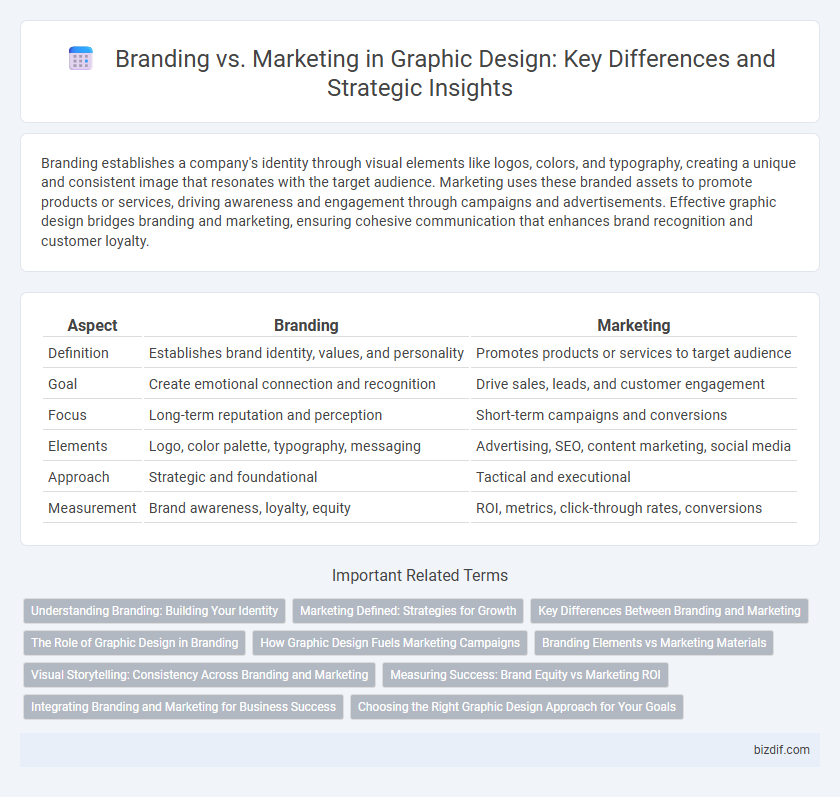Branding establishes a company's identity through visual elements like logos, colors, and typography, creating a unique and consistent image that resonates with the target audience. Marketing uses these branded assets to promote products or services, driving awareness and engagement through campaigns and advertisements. Effective graphic design bridges branding and marketing, ensuring cohesive communication that enhances brand recognition and customer loyalty.
Table of Comparison
| Aspect | Branding | Marketing |
|---|---|---|
| Definition | Establishes brand identity, values, and personality | Promotes products or services to target audience |
| Goal | Create emotional connection and recognition | Drive sales, leads, and customer engagement |
| Focus | Long-term reputation and perception | Short-term campaigns and conversions |
| Elements | Logo, color palette, typography, messaging | Advertising, SEO, content marketing, social media |
| Approach | Strategic and foundational | Tactical and executional |
| Measurement | Brand awareness, loyalty, equity | ROI, metrics, click-through rates, conversions |
Understanding Branding: Building Your Identity
Understanding branding involves crafting a distinctive visual identity that reflects your core values, mission, and unique selling proposition through logos, color schemes, typography, and consistent messaging. Effective branding creates emotional connections and fosters recognition, setting the foundation for all marketing efforts by clearly communicating who your business is to the target audience. Strong brand identity enhances customer loyalty and differentiates your business in competitive markets by establishing trust and credibility.
Marketing Defined: Strategies for Growth
Marketing encompasses strategic activities aimed at promoting products or services to a target audience, driving business growth and customer engagement. Key strategies include market research, digital advertising, content creation, social media campaigns, and performance analytics to optimize outreach and conversion rates. Effective marketing leverages data-driven insights to tailor messaging, build brand awareness, and increase sales revenue in competitive markets.
Key Differences Between Branding and Marketing
Branding defines a company's identity through logo design, color palettes, and core values, establishing emotional connections and long-term recognition. Marketing uses targeted campaigns, advertising strategies, and consumer research to promote products or services and drive sales. While branding builds foundational trust and loyalty, marketing focuses on immediate engagement and conversion metrics.
The Role of Graphic Design in Branding
Graphic design is essential in branding by creating a consistent visual identity that communicates a brand's values and personality across all platforms. It influences customer perception through logos, color schemes, typography, and imagery, ensuring immediate recognition and emotional connection. Effective graphic design strengthens brand loyalty and differentiates a business in competitive markets.
How Graphic Design Fuels Marketing Campaigns
Graphic design plays a crucial role in marketing campaigns by creating visually compelling brand identities that capture audience attention and communicate core messages effectively. Strong graphic elements such as logos, color schemes, and typography enhance brand recognition and build trust, driving consumer engagement and loyalty. By aligning design aesthetics with marketing strategies, businesses can create cohesive campaigns that increase conversion rates and maximize return on investment.
Branding Elements vs Marketing Materials
Branding elements such as logos, color schemes, typography, and brand voice establish a company's identity and emotional connection with the audience. Marketing materials including brochures, advertisements, social media content, and email campaigns leverage these branding elements to promote products and drive sales. Effective graphic design ensures consistency across both branding elements and marketing materials, reinforcing brand recognition and customer trust.
Visual Storytelling: Consistency Across Branding and Marketing
Visual storytelling in graphic design ensures consistency across branding and marketing by using cohesive elements like color schemes, typography, and imagery to reinforce brand identity. Consistent visual narratives build trust and recognition, making marketing campaigns more memorable and effective. Maintaining uniform design language across all platforms strengthens the brand's presence and supports strategic communication goals.
Measuring Success: Brand Equity vs Marketing ROI
Measuring success in branding centers on brand equity, which quantifies the value of a brand based on consumer perception, loyalty, and market position. Marketing ROI evaluates the efficiency of campaigns by comparing financial returns to marketing expenditures, providing clear metrics like cost per acquisition and conversion rates. Combining brand equity insights with marketing ROI metrics enables businesses to balance long-term brand strength with short-term campaign effectiveness.
Integrating Branding and Marketing for Business Success
Integrating branding and marketing enhances business success by creating a cohesive brand identity that resonates consistently across all marketing channels. Effective collaboration between branding strategies and marketing campaigns ensures stronger customer engagement, loyalty, and increased conversion rates. A unified approach leverages brand values and market trends to deliver targeted messages that differentiate a business in competitive markets.
Choosing the Right Graphic Design Approach for Your Goals
Selecting the appropriate graphic design approach depends on whether the focus is branding or marketing; branding emphasizes creating a consistent visual identity that reflects core values and builds long-term recognition. Marketing design targets specific campaigns with persuasive visuals aimed at driving immediate engagement and conversions. Aligning design elements with strategic objectives enhances effectiveness and ensures cohesive communication across all platforms.
Branding vs Marketing Infographic

 bizdif.com
bizdif.com